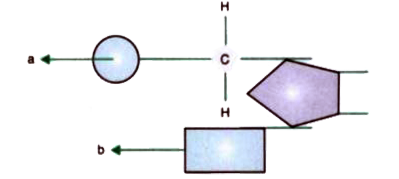Name the chemical components which constitute nucleotides. Write any two functions of nucleotides in a cell.
Step-by-Step Solution
1. Identify the Chemical Components of Nucleotides:
- Nucleotides are the building blocks of nucleic acids and consist of three main chemical components:
- Nitrogenous Bases: These can be further classified into two categories:
- Purines: Adenine (A) and Guanine (G)
- Pyrimidines: Cytosine (C), Thymine (T), and Uracil (U)
- Pentose Sugar: This is a five-carbon sugar that can be either:
- Ribose: Found in RNA (Ribonucleic Acid)
- Deoxyribose: Found in DNA (Deoxyribonucleic Acid)
- Phosphate Group: A phosphate group is attached to the sugar, which is crucial for the formation of the nucleotide structure.
2. State Two Functions of Nucleotides in a Cell:
- Energy Transfer: Nucleotides, particularly ATP (Adenosine Triphosphate), serve as the primary energy currency of the cell. ATP is used in various cellular processes, including muscle contraction, nerve impulse propagation, and biosynthesis.
- Coenzymes: Some nucleotides function as coenzymes. For example, NADP (Nicotinamide Adenine Dinucleotide Phosphate) plays a vital role in metabolic reactions, including those involved in the synthesis of nucleic acids and fatty acids.
- Nucleotides are the building blocks of nucleic acids and consist of three main chemical components:
- Nitrogenous Bases: These can be further classified into two categories:
- Purines: Adenine (A) and Guanine (G)
- Pyrimidines: Cytosine (C), Thymine (T), and Uracil (U)
- Pentose Sugar: This is a five-carbon sugar that can be either:
- Ribose: Found in RNA (Ribonucleic Acid)
- Deoxyribose: Found in DNA (Deoxyribonucleic Acid)
- Phosphate Group: A phosphate group is attached to the sugar, which is crucial for the formation of the nucleotide structure.
- Energy Transfer: Nucleotides, particularly ATP (Adenosine Triphosphate), serve as the primary energy currency of the cell. ATP is used in various cellular processes, including muscle contraction, nerve impulse propagation, and biosynthesis.
- Coenzymes: Some nucleotides function as coenzymes. For example, NADP (Nicotinamide Adenine Dinucleotide Phosphate) plays a vital role in metabolic reactions, including those involved in the synthesis of nucleic acids and fatty acids.
Topper's Solved these Questions
- BIOMOLECULESBOOK - ICSECHAPTER - BIOMOLECULESEXERCISE - EXERCISE (PART-II)(DESCRIPTIVE QUESTIONS)(LONG ANSWER QUESTIONS)
31 Videos
- BIOMOLECULESBOOK - ICSECHAPTER - BIOMOLECULESEXERCISE - ISC EXAMINATION QUSTIONS (PART-I)(DESCRIPTIVE QUESTIONS)
21 Videos
- BIOMOLECULESBOOK - ICSECHAPTER - BIOMOLECULESEXERCISE - EXERCISE (PART-II)(DESCRIPTIVE QUESTIONS)(VERY SHORT ANSWER QUESTIONS)
85 Videos
- APPENDIX II ( TYPICAL CONVERSIONS)BOOK - ICSECHAPTER - APPENDIX II ( TYPICAL CONVERSIONS)EXERCISE - AROMATIC CONVERSIONS
98 Videos
- CHEMICAL KINETICSBOOK - ICSECHAPTER - CHEMICAL KINETICSEXERCISE - ISC EXAMINATION QUESTIONS (NUMERICAL PROBLEMS )
57 Videos
Similar Questions
Knowledge Check
The three major components that constitute a typical cell are :
Aplasma membrane, nucleus, organellesBorganelles, nucleus, cytosolCcytosol, organelles, plasma membraneDplasma membrane, cytosol, nucleus
Name the two components of lichen.
View SolutionWhich one is a nucleotide ?
View SolutionWhat do you mean by a nucleotide ? Write two functions of DNA.
View SolutionDefine nucleotides and give their functions.
View SolutionWhich two are nucleotides

View SolutionWhat are the components of a nucleotide ?
View SolutionName the components ‘a’ and ‘b’ in the nucleotide with a purine below

View Solution
